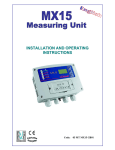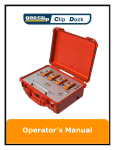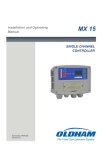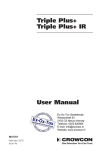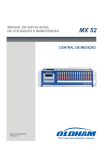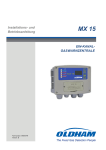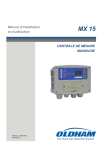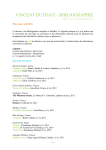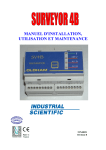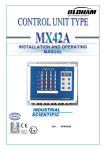Download INSTALLATION AND OPERATING INSTRUCTIONS - Ex-Ox-Tox
Transcript
INSTALLATION AND OPERATING INSTRUCTIONS Ref : NPM15GB Warnings Read these instructions carefully before installation and start-up particularly ensuring compliance with the instructions regarding safety of equipment with regard to the intermediary or final user. The electrical installation and connections should be performed by qualified personnel in accordance with the manufacturer instructions and the standards of competent authorities in the industry. Non-compliance with the instructions may have a serious impact on people’s safety. Strict compliance is required particularly for electrical installation and assembly (connections, service lines). Any modification of the equipment as well as use of unauthorized parts will result in cancellation of any warranty. The central unit is designed to be used for specific purposes that are indicated in the technical specifications. It is not authorized to exceed the specified values in any case. This document is not contractually binding. In the interests of its customers, INDUSTRIAL SCIENTIFIC reserves the right to modify the technical specifications of its equipment without notice in order to improve its performance. Signalling Operating ground terminal Attention! Risk of electric shock. Attention (see accompanying documents) 3 GAS DETECTION We are delighted that you have chosen an INDUSTRIAL SCIENTIFIC instrument and would like to thank you for your choice. We have taken all the necessary measures to ensure that your instrument provides total satisfaction. Now it is important to read this document carefully. EXTENT OF RESPONSIBILITY * INDUSTRIAL SCIENTIFIC declines its responsibility towards any person for material damage, physical injury or death resulting wholly or partly from inappropriate use, installation or storage of its equipment resulting from failure to observe instructions and warnings and/or standards and regulations in force. * INDUSTRIAL SCIENTIFIC neither supports nor authorises any company, physical or moral person to assume responsibility on behalf of INDUSTRIAL SCIENTIFIC , even if it is involved in the sale of INDUSTRIAL SCIENTIFIC products. * INDUSTRIAL SCIENTIFIC cannot be held responsible for direct or indirect damage or be required to pay direct or indirect compensation resulting from the sale or use of any of its products IF THESE PRODUCTS HAVE NOT BEEN DEFINED AND CHOSEN BY INDUSTRIAL SCIENTIFIC FOR THEIR SPECIFIC USE. CLAUSES CONCERNING PROPERTY * Drawings, plans, specifications and information included in this document contain confidential information that is the property of INDUSTRIAL SCIENTIFIC * None of this information may be reproduced, copied, divulged or translated, by physical, electronic or any other means, nor used as the basis for the manufacture or sale of INDUSTRIAL SCIENTIFIC equipment or for any other reasons without prior consent from INDUSTRIAL SCIENTIFIC WARNINGS * This document is not contractually binding. In the interests of its customers, INDUSTRIAL SCIENTIFIC reserves to modify the technical specifications of its equipment without notice, in order to improve its performance. * READ THIS MANUAL CAREFULLY BEFORE FIRST USE OF THE EQUIPMENT: this manual must be read by any person who is or will be responsible for using, maintaining or repairing this equipment. * This equipment will only provide the announced performance levels if it is used, maintained and repaired according to INDUSTRIAL SCIENTIFIC directives, by INDUSTRIAL SCIENTIFIC personnel or by personnel approved by INDUSTRIAL SCIENTIFIC GUARANTEE 2 years guarantee in normal conditions of use on parts and technical labour, return in our workshops, excluding consumables (sensors, filters, etc.) 4 Table of contents I. PRESENTATION .......................................................................................................................................6 II. TECHNICAL SPECIFICATIONS .....................................................................................................6 1. CHARACTERISTICS ...................................................................................................................................6 III. DETAIL SPECIFICATIONS FOR USE IN EXPLOSIVE ATMOSPHERES IN ACCORDANCE WITH THE ATEX 94/9/CE EUROPEAN DIRECTIVE...................................................8 1. 2. 3. SPECIFICATIONS FOR MECHANICAL AND ELECTRICAL INSTALLATION IN CLASSIFIED ZONE.....................8 METROLOGICAL SPECIFICATIONS ............................................................................................................8 CONNECTION OF DETECTORS OTHER THAN INDUSTRIAL SCIENTIFIC TO THE MX15 CENTRAL UNIT 9 3.1. Transfer curves of central unit in configuration 0 at 100% LEL .......................................................9 3.2. Power supply and load resistance characteristics ...........................................................................10 4. MARKING ..............................................................................................................................................10 IV. 1. 2. CENTRAL UNIT INSTALLATION ................................................................................................10 CENTRAL UNIT MOUNTING.....................................................................................................................10 CENTRAL UNIT ELECTRICAL CONNECTIONS ...........................................................................................10 2.1. Protective ground.............................................................................................................................10 2.2. Power supply....................................................................................................................................11 2.2.1. Power supply 230 Volts (115VAC on request)..........................................11 2.2.2. Power supply 24 VDC (protection through F8) can be connected on terminals 0 and +24V, as indicated in the wiring examples at the end of the manual. 11 2.3. Measuring channel...........................................................................................................................11 2.3.1. 2.3.2. 2.3.3. 2.3.4. V. Sensors .......................................................................................................11 Alarm relays ...............................................................................................12 Fault relays .................................................................................................12 Remote acknowledgment ...........................................................................12 OPERATING INSTRUCTIONS.......................................................................................................13 1. INSTRUCTIONS ON THE DISPLAY UPON ACTIVATION:..............................................................................13 Measuring channel display ..............................................................................................................13 2. MENUS ..................................................................................................................................................13 2.1. Menu viewing ...................................................................................................................................13 2.2. Menu validation ...............................................................................................................................13 2.3. To exit while viewing a menu (ECHAP)...........................................................................................14 2.4. Programming menu..........................................................................................................................14 2.5. Initialisation menu (INI)- Start-up ...................................................................................................15 2.6. Code (access) menu .........................................................................................................................15 2.7. Buzzer menu .....................................................................................................................................15 2.8. TEST menu (TST) .............................................................................................................................15 Attention: this menu should be used for calibration after a first start-up. ..................................................15 3. TESTING OF RELAYS AND EXTERNAL CONTROLS .................................................................................17 4. CLEANING .............................................................................................................................................17 5. CENTRAL UNIT MAINTENANCE...............................................................................................................17 6. REPLACEMENT OF FUSES .......................................................................................................................18 7. SCRAPPING OF MX15..............................................................................................................................18 1.1. VI. SPARE PARTS ...................................................................................................................................18 VII. EXAMPLES OF CONNECTIONS ...................................................................................................19 5 I. Presentation The MX15 measuring and alarm unit has been designed for simple facilities that do not require the implementation of an electrical cabinet. The MX15 central unit can be connected to combustible or toxic gas detectors or oxygen detectors. The measurement of the sensor is displayed on the MX15 central unit and compared to alarm thresholds. In the event that the threshold is exceeded, the central unit activates the relays that can control external units. The MX15 central unit consists of the following components: • A wall case with access «hatch» to settings (potentiometers) • A motherboard including all system components (power supply, display, relays and connectors • A front face with tactile keys. II. Technical specifications 1. Characteristics Mounting Box on DIN rail Dimensions: 185 * 157 * 67 mm Materials: ABS type plastic Cable inputs/outputs: 3 cable gland type M20 cable diameter 5.5 to 12 mm 1 cable gland M16: diameter 4 to 8 mm direct input available through wall crossing Protection: IP31 Electric power supply 230 VAC or 115VAC upon request and 21 V at 30 VCC Consumed power: 16 VA Operating conditions Ambient temperature: -10 to +45°C Storage temperature: -10 to +40°C Humidity: 5% to 95% non-condensed Embedded audible alarm: through buzzer Number of measuring channels 1 6 Number of sensors: *1 OLC10-type combustible gas detector or 2 OLC10 TWIN detectors for detection of methane, butane, propane in boiler rooms and GPL, GNV or H2 in parking lots *1 OLCT10-type combustible gas detector for detection of methane, butane, propane in boiler rooms and GPL, GNV or H2 in parking lots *1 to 5 detectors of same type OLCT10 for detection of CO, NO, NO2. Cable length: OLC10 and OLC10 TWIN: max. 300 m at 3x1.5 mm² (4x1.5 mm² between the two OLC10 TWIN) OLCT10 EXPLO: 1,000 m at 1.5 mm² OLCT10 TOX: 2,000 m at 1.5 mm² Measurement: continuous Measuring ranges programmable Display front Type: LCD screen 4 digits 7 segments, 3 characters 14 icon segments 4 LEDs Description of unit and gas: programmable by user in a list 3 characters edited by user Keyboard: through tactile keys for access to menus, indicator test, acknowledgment Alarms Type: 2 independent thresholds defined by user manual or automatic erasure by increasing or decreasing value through programming viewing through red indicator relay output (alarm 1 and 2) Relays 2 independent alarm relays with positive/negative safety programmable by manufacturer. 1 out of order relay in positive safety break or make contact that may be configured on all relays using a jumper Cutoff level 2A / 250 Volts AC/ 30 volts DC Connection Type: Cable section: spring terminals maximum 2.5 mm² 7 Remote acknowledgment through short circuit of 2 MX15 terminals, using an external potential-free dry contact (maximum 2 meters) Certification ATEX 94/9/CE Directive: category (3)G for metrology in explosive gas detection EN 61779-1 and 4 in zones 2. Low-voltage directive: in accordance with EN 61010 Electromagnetic Compatibility Directive CEM: in accordance with EN 50270 III. Detail specifications for use in Explosive Atmospheres in accordance w ith the ATEX 94/9/CE European Directive The MX15 detection central unit, designed for measurement of explosive gas, is compliant with the requirements of the ATEX 94/9/CE European Directive regarding explosive atmospheres. Thanks to its metrological performance, the MX15 central unit associated with the INDUSTRIAL SCIENTIFIC CEX300 and OLC 10 detectors is a safety device for ATEX Zone 2 classified areas. The central unit can also reduce the risk of explosion through information provided to external units. The site manager where the equipment is installed should take into consideration and comply with the information in the following paragraphs. Refer to the provisions of the ATEX 1999/92/CE European Directive regarding the enhancement of safety and health of the workers exposed to risks of explosive atmospheres. 1. Specifications for mechanical installation in Classified Zone and electrical Installation will be performed in accordance with existing standards, in particular, EN 60079-14, EN 60079-17 standards. The MX15 central unit should not be exposed to mechanical vibrations and should be installed in a safe area, away from explosive atmospheres. It is essential to refer to the operating and start-up instructions of the above-mentioned gas detectors in paragraph ‘Detail specifications for use in explosive atmospheres in accordance with the ATEX 94/9/CE European Directive.’ 2. Metrological Specifications The central unit complies with the metrological European standards EN61779 and EN61779-4 for methane (calibration gas), butane, propane and hydrogen (gas as per response curves), when the central unit is used with CEX300 and OLC 10 gas detectors. 8 In the event that the central unit is used with other types of sensors supplying a measuring current of 4/20 mA, they should comply with paragraph 1.5 of Appendix II of the Atex 94/9/CE Directive and be compatible with their characteristics (see central unit transfer curve). Note: the test vibrations in accordance with EN61779-4 paragraph 4.13 have not been performed because they do not apply due to the operating conditions of the MX15 central unit. 3. Connection of detectors other than SCIENTIFIC to the MX15 central unit I N D U S T R I AL As previously explained, the user who want to connect detectors other than INDUSTRIAL SCIENTIFIC, should ensure that they are compatible with the central unit so that the unit is considered a safety device. 3.1. Transfer curves of central unit in configuration 0 at 100% LEL The following curve provides a response to the central unit regarding the measured value and fault processing, based on the value of the input current supplied by the detector. In the event that the user connects a detector of a brand other than INDUSTRIAL SCIENTIFIC to the MX15 central unit, he/she should ensure that the transfer curve is compatible with the input characteristics of the central unit, so that the information provided by the detector is accurately interpreted. In addition, the central unit should supply a sufficient supply voltage taking into account the cable drops. Display in % LEL SUP Fault 100 % LEL 0 % LEL -15 % LEL Fault 1.6 4 mA mA 20 mA Signal supplied by the detector in mA Caution: When the measurement is >= to 100% LEL, the measuring unit memorizes this scale overrun, the channel passes to alarm and fault mode. The resetting of this status is manual and is the responsibility of the user who should comply with the safety instructions of his/her site. The resetting is either validated through an ON/OFF of the central unit or through a maintenance operation. 9 3.2. Power supply and load resistance characteristics Maximum current available between terminals 2 and 3: 300 mA at 20 V. Maximum no load voltage between terminals 2 and 3: 30 V Load resistance between terminals 1 and 2: 47 ohms 4. M arking OLDHAM Arras II (3) G OSA 05ATEX0120 IV. Central unit installation 1. Central unit mounting Mounting is performed using a DIN rail, positioned so that it provides a 5 cm free area around the central unit. The MX15 central should be installed in all facilities away from explosive atmosphere, preferably in an attended area (control centre, console room, control room, etc.) and in a less humid (no condensation) and temperate environment (see chapters 2.1 and 3) 2. Central unit electrical connections Electrical connections should: - be performed by a specialist and while the central unit is off (power supply is shut off) - comply with existing regulations (including NF C 15-100) - has a minimum section of 1.5 mm² and a maximum section of 2.5 mm2 for power supply from power system (230VAC) Check the current nature and network voltage (the network voltage should match the voltage specified on the central unit maker’s plate). 2.1. Protective ground The central unit must be connected to an operating ground. The ground terminal (yellow ochre) is identified by the following symbol: Refer to wiring examples at the end of the manual. 10 2.2. Power supply 2.2.1. Power supply 230 Volts (115VAC on request) 230VAC is standard power supply: protection is provided - either through F8= 630 mA/250VAC either through F6/F7 = 100 mA/250VAC F8 A special “115VAC” configuration is provided by the manufacturer upon request. The central unit should be protected upstream through a bipolar differential circuit breaker. The response curve is of type D. The mains should be wired on the two terminals L (orange) and N (blue), as indicated in the wiring examples at the end of manual. 2.2.2. Power supply 24 VDC (protection through F8) can be connected on terminals 0 and +24V, as indicated in the wiring examples at the end of the manual. 2.3. Measuring channel 2.3.1. Sensors The various types of sensors should be connected on the terminals C1, C2 and C3 (white) of the connector as indicated in the wiring examples at the end of manual. The "Wheatstone bridge"-type "explosive gas " sensors with 3 active wires: C1: C2: C3: median point (signal) detector filament (-) compensator filament (+) 11 Sensors/transmitters 4/20 mA with 2 active wires : C1: C2: C3: signal (current return to ground) not connected positive power supply (+24 Volts) Sensors/transmitters 4/20 mA with 3 active wires : C1: C2: C3: signal (current return to ground) power supply 0 Volt positive power supply +24 Volts 1. For each sensor family, the manufacturer will insert a programming support (Explo 340mA or 4 -20mA) to the circuit: see above figure. 2. Note: if several OLCT10 toxic sensors are connected (maximum 5), programming of the electronic circuit is required, which should be performed by an authorized person. 2.3.2. Alarm relays The MX 15 central unit has two alarm relays corresponding to two pre-programmed instant alarm thresholds. The relays are in positive safety (negative upon request) and potential-free. REL1 terminals match the relay 1 contacts (alarm 1). REL2 terminals match the relay 2 contacts (alarm 2). The relay contacts can be used “normally open or closed” moving the appropriate jumper (next to relays) The relay contacts are potential-free. Refer to the wiring examples at the end of manual. 2.3.3. Fault relays The fault relay is in positive safety. The DEF terminals match the fault relay contacts (fault). The relay contacts can be used “normally open or closed” moving the appropriate jumper (next to the relay) The relay contacts are potential-free. Refer to the wiring examples at the end of the manual. 2.3.4. Remote acknowledgment A pushbutton for “remote acknowledgment” may be connected to the MX15 central unit to the “acknowledgment” terminals (dry and potential-free contacts) at a maximum 2-meter distance. Refer to the wiring examples at the end of manual. 12 V. Operating instructions 1. Instructions on the displa y upon acti vati on: Upon activation of the central unit a list of information is automatically displayed on the display unit: software version, maintenance access code, pre-programmed alarm thresholds, stabilisation time sheet, etc. and then the measurement continuously supplied by the sensor. 1.1. Measuring channel display The MX 15 central unit continuously displays the measurement; however, by simultaneously pressing the + and – keys of the front keyboard, the measurement will be replaced with an interrupted line on the display unit. To return to the measurement display, press one of the two keys, + or - . To return to normal operation, simultaneously press the + and – keys. 2. Menus Reminder: for safety purposes, only authorized and trained people are allowed to use the following menus. 2.1. Menu viewing To exit the normal operating mode and access the menu list, use the front keyboard: - press the MENU key use + / - and ENTER keys, validate the standard access code « 1000 » use + or – key to view the available menus, such as: PROGRAMMING (PRG) USI (factory calibration) * INITIALISATION (INI) CODE (COD) BUZZER (BUZ) TEST (TST) * the USI menu is not detailed below because it is only reserved for the manufacturer: never use it without previous training! ** * * 2.2. Menu validation - display the desired menu as indicated in the previous chapter validate this menu by pressing the ENTER key 13 2.3. To exit while viewing a menu (ECHAP) Simultaneously press the + and - keys and validate or don’t validate the recording of potentially modified parameters: - press ENTER to abort without any change press «+», then ENTER to exit by validating the changes. 2.4. Programming menu A maintenance key • is displayed while using the programming menu This allows programming of parameters of the measuring channel such as: - - On/off: yellow DEL is blinking Detected gas chemical symbol (CH4 /CO, etc.) Measuring unit (%LEL/ppm, etc.) Measuring scale and decimal point (0.1/1.0/10/100/1000, etc.) Programming of two gas alarm thresholds (characteristics): corresponding red DEL is on during this step Selecting the erasure type of gas alarms 1. manual (MAN) = if the gas concentration again becomes lower than the preset alarm threshold, this alarm must be acknowledged manually by pressing the acknowledgment key 2. or automatical (AUT) = if the gas concentration again becomes lower than the preset alarm threshold, the acknowledgment is automatic. Timing (in minutes and seconds) of the alarm relay activation time: yellow DEL is blinking MA Diagram of alarm activation Exceeding alarm threshold - - DEL Alarm and Buzzer Timing AL relay cutover Timing (in minutes and seconds) of the fault relay activation time: yellow DEL is on continuously Timing of the central unit upon activation (relays disabled): yellow DEL is blinking and the following icon is displayed. Indicating the type of sensor used, such as: • • • • • Bridge: in bridge (filaments), types OLC10, CEX300, etc. EHP: EXPLO (explo. 4/20mA), type OLCT10, etc. InC: fire (ionic, optical, etc.) O2: oxygen Aut: other (toxic, etc.) 14 - Indicating the maintenance mode, MAN or AUT: - AUT: Detection of detector calibration mode of this function (yellow DEL blinking on MX15) - MAN: No detection of detector calibration mode - Timing (in minutes and seconds) upon exit of «calibration» menu (relays disabled) Validation of potentially modified parameters in this menu (yes or no): - If “NO” validated: the changes are not taken into contact If “YES” validated: the new programming will be saved. 2.5. Initialisation menu (INI)- Start-up This menu is used to INITIALISE the microprocessor based on the connected sensor It is used in the following cases: - by INDUSTRIAL SCIENTIFIC when new equipment is shipped - during the first installation - during a cell or sensor replacement 2.6. Code (access) menu This menu changes the access code for various menus (1000 in standard upon shipment of equipment): - display the CODE menu (+ and – key) validate it (enter) display current code indicate the new code using the + and – keys validate this new code (enter) finally confirm it (yes/no/enter) 2.7. Buzzer menu Allows or does not allow the use of the buzzer embedded to the MX15 central unit: - display the BUZZER menu (+ and – keys) validate it (enter) validate ON (active buzzer) or OFF (buzzer off) finally confirm (yes/no/enter) 2.8. TEST menu (TST) Disables the relays embedded to MX15 upon voluntary activation of alarms through injection of a standard gas on the sensor to test the alarms or to calibrate: - display the TST menu (+ and – keys) validate it (enter): yellow DEL is blinking - yellow DEL is blinking, the TST message and the the relays are disabled during the test or calibration key are displayed, confirming that Attention: this menu should be used for calibration after a first start-up. 15 INDUSTRIAL SCIENTIFIC recommends: Calibrate the sensor connected to the MX15 central unit at least once a year, then based upon environmental conditions (T°, dust, vibrations etc.). It is also recommended to calibrate the detector upon exposure to high gas concentrations. Reminder: for safety purposes, only authorized and trained people are allowed to use the following menus. Procedure to be followed when the MX15 central unit is connected to an explosive gas sensor (OLC10/CEX300, etc.): - the TEST menu was validated (see above) remove the small cover on the front of MX15 to access the setting potentiometers adjust, if needed, the ZERO (read the display unit) using a zero potentiometer «O» Reminder: make sure that you have clean air - otherwise inject air or nitrogen on the sensor (with calibration kit) with a flow rate of 60 l/h, then wait for the stabilisation of measurement - Now inject the standard gas (60l/h) on the sensor and wait for the measurement stabilisation Make sure that the gas concentration is correct by reading the display unit Otherwise, adjust the sensitivity using a “S” potentiometer Disconnect the standard gas cylinder Wait for the “return to zero” on the display unit Press the TEST key to exit this menu The yellow “DEL” is off and the display unit indicates an interrupted line Press one of the two keys + or – to display the measurement, if needed Position the small cover in place. Procedure to be followed when a MX15 central unit is connected to a transmitter 4-20 mA without local maintenance device (calibration position switch, etc.) : - - the TEST menu was validated to disable the relays of the central unit: see the beginning of this chapter adjust the transmitter (see manual of relevant product) make sure that the transmitter instructions (O and S) match those of the central unit. Refine the adjustments, if needed, of the central unit and, in this case, refer to the previous paragraph upon completion of calibration, wait for the «return to zero» on the display unit of the central unit Press the TEST key to exit this menu Yellow “DEL” is off and the display unit shows an interrupted line Press one of the two keys + or – to display the measurement, if needed. 16 3. TE S TI NG of r e l a ys a n d e x t e r na l c on t r ol s It is also recommended to periodically check alarm activation and the corresponding external controls. 4. Cleaning Do not use alcohol or ammonia-based liquids to clean the central unit. If needed, clean the outside of the case with a damp cloth. 5. Central unit maintenance The central unit does not require special maintenance. If sensor calibration is required, this operation should only be performed by qualified personnel. Gas detection instruments are potential life-saving devices. Recognizing this fact, Industrial Scientific Corporation recommends that a functional “bump” test be performed on every fixed gasmonitoring instruments as part of a regular maintenance program. A functional test is defined as a brief exposure of the detector to a concentration of gas(es) in excess of the lowest alarm set-point for each sensor for the purpose of verifying sensor and alarm operation and is not intended to be a measure of the accuracy of the instrument. Industrial scientific further recommends that a full instrument calibration be performed using a certified concentration(s) of calibration gas(es) quarterly, every 3 months.* Calibrations may be necessary more or less frequently based, for example, on application, field conditions, exposure to gas, sensor technology, and environmental conditions. The frequency of calibration is best determined by company policy or local regulatory agencies. If an instrument fails to operate properly during any functional “bump” test, a full instrument calibration should be performed successfully prior to use. These recommendations are based on safe work procedures, industry best practises, and regulatory standards to ensure worker safety. Industrial scientific is not responsible for setting safety practices and policies. * For new installations it may be prudent to carry out bump tests frequently at first (perhaps weekly), increasing the time intervals (to, perhaps, monthly or more) as confidence grows with experience in the installation concerned, on the basis of the maintenance record. • REFER TO CHAPTERS 4.2.5 AND 4.2.8 (INITIALISATION AND TEST) • Do not forget to initialise the system upon cell replacement: use the “INI” menu (chapter 4.2.5). 17 6. Replacement of fuses Fuse replacement should be performed only by qualified personnel. List and type of fuses used in the MX15 central unit: the fuses used should comply with CEI 127, should be timed and have a low cutoff power. 7. Scrapping of mx15 Concerning the conservation, of the protection and the improvement of the quality of the environment, as well as for the protection of the health of the persons and the careful and rational use of natural resources, MX15 has to be the object of a selective collection for the electronic equipments and cannot be scrapped with the normal domestic waste. The user thus has the obligation to separate the MX15 of the other waste so as to guarantee that it is recycled in a sure way at the environmental level. For more details of the existing sites of collection, contact the local administration or the distributor of this product. VI. - Spare parts Fuse 630 mA/ref. 6154627 Full electronic map/ref. 6451569 Potentiometer cover/ref. 6123711 Cover retention screw /ref. 6902569 Equipped ready front cover (self-adhesive front panel, small cover mounted, 4 screws)/ref. 6323648 18 VII. Examples of connections JUMPER L N T MAINS 230VAC DEF RL1 RL2 0 +24V Remote acknowledgment 1 relay contact outputs: potential-free NO or NF based on position of jumpers next to relays. 3 Connector of first sensor with 2 wires. MX15 CENTRAL UNIT 1 3 31 31 31 31 31 31 IN OUT IN Example of connection between a MX15 central unit and two OLCT10-type sensors for detection of the same gas (maximum 5 sensors) . 19 JUMPER L N T DEF MAINS 230VAC RL1 0 +24V RL2 Remote acknowledgment relay contact outputs: potential-free NO or NF based on position of jumpers next to relays. 1 2 3 Connector of first sensor with 3 active wires. MX15 CENTRAL UNIT 1 2 3 1 2 4 3 2 14 3 2 1 OUT IN Example of connection between a MX15 central unit and two OLC10 TWIN-type sensors. 20 4321 OUT 4321 IN DEF JUMPER RL2 Jumper RL1 Jumper L N T DEF MAINS 230VAC RL1 0 +24V RL2 Remote acknowledgment relay contact outputs: potential-free NO or NF based on position of jumpers next to relays. 1 2 3 Connector of sensor with 3 active wires. 1 1 2 2 3 3 Connect the 3 wires based on numbering Example of connection with an EXPLO or TOXIC sensor with 3 active wires. 21 22 Ex-Ox-Tox Gasdetectie Westerdreef 5V 2152 CS Nieuw-Vennep Telefoon: 0252 620885 E-mail: [email protected] Website www.exoxtox.nl 23






















